|
|
|
Sort Order |
|
|
|
Items / Page
|
|
|
|
|
|
|
| Srl | Item |
| 1 |
ID:
153181
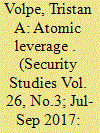

|
|
|
|
|
| Summary/Abstract |
Nuclear proliferation is not a binary outcome with uniform consequences, but instead spans a continuum of latent capacity to produce nuclear weapons. At various thresholds of technical development, some countries leverage nuclear latency to practice coercive diplomacy. How and when does nuclear technology provide a challenger with the most effective means to extract concessions in world politics? This article claims that compellence with nuclear latency puts a challenger on the horns of a credibility dilemma between demonstrating resolve and signaling restraint, and identifies a sweet spot for reaching an optimal bargain where the proliferation threat is credible while the assurance costs of revealing intent are low. Historical studies of South Korea, Japan, and North Korea validate this Goldilocks principle and find that it consistently reflects the ability to produce fissile material. Contrary to conventional wisdom about proliferation, nuclear technology generates political effects long before a country acquires nuclear weapons.
|
|
|
|
|
|
|
|
|
|
|
|
|
|
|
|
| 2 |
ID:
074667


|
|
|
|
|
| Publication |
2006.
|
| Summary/Abstract |
Despite decades of research on coercive diplomacy, the linkage between deterrence and compellence still remains unexplored. The present essay provides both a theoretical and empirical analysis of why studying their linked relationship is desirable. After overviewing the literature, it investigates the interplay between US strategies of deterrence and compellence in the First Gulf Crisis (1990-1991), suggesting that the deterrence-compellence linkage is stronger when the two strategies coexist or after they have coexisted. In particular, such a linkage was absent at the beginning of the First Gulf Crisis but very much present from the middle of the crisis until its end. Although this essay represents only a preliminary foray into exploring the potential linkage between deterrence and compellence, it appears that a better grasp of this relationship could provide us with the tools to counteract as well as reduce the negative effects of miscalculation and misperception, practices that are partially responsible for unpredicted and unwanted outcomes in international politics.
|
|
|
|
|
|
|
|
|
|
|
|
|
|
|
|
| 3 |
ID:
165258


|
|
|
|
|
| Summary/Abstract |
Theories of crisis bargaining suggest that military mobilizations act as costly signals of resolve, increasing the credibility of coercive threats. In this article, I argue that air mobilizations, as a subset of military signals, demonstrate a lack of resolve during coercive bargaining for four reasons: they cost less in terms of human and financial resources (sunk costs), generate lower political costs (hand-tying), do not raise the risks of engagement (manipulation of risk), and do not significantly shift the balance of power—all compared with other military signals. Using new data that disaggregates military demonstrations into air, naval, and land signals during 210 cases of compellence, this article presents systematic evidence that air signals decrease the probability of coercive threat success compared with the alternatives. This finding holds important implications for theoretical and policy debates regarding the role of costly signals in international bargaining.
|
|
|
|
|
|
|
|
|
|
|
|
|
|
|
|
| 4 |
ID:
164156
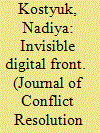

|
|
|
|
|
| Summary/Abstract |
Recent years have seen growing concern over the use of cyber attacks in wartime, but little evidence that these new tools of coercion can change battlefield events. We present the first quantitative analysis of the relationship between cyber activities and physical violence during war. Using new event data from the armed conflict in Ukraine—and additional data from Syria’s civil war—we analyze the dynamics of cyber attacks and find that such activities have had little or no impact on fighting. In Ukraine—one of the first armed conflicts where both sides deployed such tools extensively—cyber activities failed to compel discernible changes in battlefield behavior. Indeed, hackers on both sides have had difficulty responding to battlefield events, much less shaping them. An analysis of conflict dynamics in Syria produces similar results: the timing of cyber actions is independent of fighting on the ground. Our finding—that cyber attacks are not (yet) effective as tools of coercion in war—has potentially significant implications for other armed conflicts with a digital front.
|
|
|
|
|
|
|
|
|
|
|
|
|
|
|
|
| 5 |
ID:
099569


|
|
|
|
|
| Publication |
2010.
|
| Summary/Abstract |
In recent considerations of deterrence in strategic studies, there are almost no works that would systematically link deterrence to one of the most important current issue areas of contemporary strategic studies: ballistic missile defence (BMD). In an attempt to address this lacuna, this article considers ways in which missile defence has been - and can be - intertwined with deterrence of the 21st century. The article begins with a historical outline of the relationship between nuclear deterrence and BMD, and continues by comparing and contrasting US political and strategic-planning discourses in how they have addressed the examined relationship. What follows is the recasting of traditional understanding of deterrence as a set of disparate modalities underpinned by different principles and organizing logics. The article will show the role and function of BMD in three relevant modalities of deterrence in the 21st century: first, in a renewed strategic deterrence between the USA and Russia based on an axiomatic logic of MAD; second, in the deterrence of rogue states in reaction to their asymmetric nuclear threats; and, finally, in a reverse deterrence from intervention in regional conflicts. Consequently, the presented outline of the three modalities will be theoretically furthered to allow for conceptualization of possible links to BMD in ways in which practical implications for future research, strategic planning and political action can be seen.
|
|
|
|
|
|
|
|
|
|
|
|
|
|
|
|
| 6 |
ID:
177064
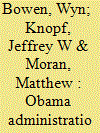

|
|
|
|
|
| Summary/Abstract |
This article examines responses to the Syrian government’s possession and eventual use of chemical weapons (CW) in that country’s civil war from 2012 to 2013. During this time, the United States and other outside powers applied coercive strategies, in both deterrent and compellent modes. Outcomes varied: compellence in the form of coercive diplomacy achieved a partial success, getting Syria to give up much of its chemical stockpile, but there were multiple deterrence failures, culminating in a large-scale sarin gas attack in August 2013. We examine this record to draw lessons about factors associated with the effectiveness of coercion. Our analysis draws on insights from existing research on both deterrence and coercive diplomacy to develop an integrated analytical framework involving the interplay of three factors: credibility, motivations, and assurance. We find the typical default approach to coercion, based on demonstrating toughness and threatening to impose costs using airpower—an approach we call the “resolve plus bombs” formula—was not sufficient to change Syria’s calculations regarding chemical use.
|
|
|
|
|
|
|
|
|
|
|
|
|
|
|
|
| 7 |
ID:
105234


|
|
|
|
|
| Publication |
2011.
|
| Summary/Abstract |
The centrality of military coercion in contemporary Western crisis and conflict management constitutes a major policy problem because the United States and its allies are poor at translating their overwhelming military superiority into adversary compliance. The standard explanation provided by coercion theorists is that coercion is hard and that miscalculation, misperception, or practical problems can defeat even a perfectly executed strategy. What they ignore is that the problem also stems from the limits of coercion theory, which has left us with an unnecessarily poor understanding of how military coercion works and how the practical problems involved could be addressed. Our understanding of military coercion would be increased markedly if only coercion theorists would make a greater efforts to do three things, namely (1) provide clear operational definitions of key concepts and variables, (2) engage in systematic and rigorous empirical analysis of generally accepted propositions, and (3) seek to provide solutions to the many policy problems that coercion theorists have identified to date. These simple steps would enhance the degree of cumulativity within the field, provide the principal theoretical propositions with a firmer empirical foundation and make military coercion theory more useful for policy makers.
|
|
|
|
|
|
|
|
|
|
|
|
|
|
|
|
| 8 |
ID:
183782
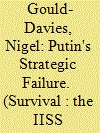

|
|
|
|
|
| Summary/Abstract |
Russian President Vladimir Putin’s invasion of Ukraine was a grand strategic error. He underestimated Ukraine’s cohesion and will to resist, the West’s unity and resolve, the vehemence of Russia’s domestic opposition and the wariness of Russian elites. While Putin’s resort to war reflected Russia’s limited options for trying to halt Ukraine’s drift away from its remaining pull, the war itself has shattered myths about Russia’s own strength. It has exposed economic vulnerability, serious failures of military planning and battlefield execution, and deficits in information and cyber warfare. Mooted compromises involving Ukraine’s partition or neutrality do not yet feel like stable solutions whose terms all sides will accept. Parallel escalation by Russia and the West appears to be the prevailing dynamic. But even if Russia out-escalates the West, the costs of victory will be very large, not least on the home front.
|
|
|
|
|
|
|
|
|
|
|
|
|
|
|
|
| 9 |
ID:
074959
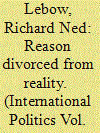

|
|
|
| 10 |
ID:
193016
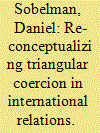

|
|
|
|
|
| Summary/Abstract |
Although coercion literature has traditionally focused on two-actor dyads, coercion in three-actor settings is a prevalent yet understudied strategy in International Relations. Such cases of “triangular coercion” represent a phenomenon whereby a coercer who lacks direct leverage over a resilient target coerces a third party who does possess leverage over the target, and to whom the target is vulnerable, and manipulates it into a clash of interests with the target. By forcing an otherwise uninvolved intermediary to align with the coercer, a coercer can alter the balance of vulnerability vis-à-vis its otherwise resilient target and enhance its susceptibility to coercion, albeit by extension. Existing scholarship tackles triangular coercion from different angles and mostly focuses on actor typology. This article seeks to promote our understanding of this strategy by proposing a conceptual model that distills its logic into the abstract components of vulnerability, resilience, and leverage. To demonstrate the dynamics of triangular coercion, the article draws on three empirical cases: Israel’s failed attempts to force Lebanon to rein in Hezbollah in the 1990s, Nazi Germany’s successful manipulation of Britain and France into coercing Czechoslovakia in 1938, and the Soviet Union’s success at forcing the United States to coerce Israel in 1973.
|
|
|
|
|
|
|
|
|
|
|
|
|
|
|
|
| 11 |
ID:
157900
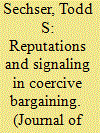

|
|
|
|
|
| Summary/Abstract |
When do states defend their reputations? States sometimes pay high costs to protect their reputations, but other times willingly tarnish them. What accounts for the difference? This article investigates reputation building in the context of coercive diplomacy. In coercive bargaining, giving in to a challenge can harm one’s reputation. I argue, however, that states value their reputations less—and therefore are more willing to capitulate to coercive threats—when they do not expect future challenges. Using a data set of more than 200 coercive threats, empirical tests find support for this logic. Coercers that are constrained in their ability to initiate future challenges exhibit higher rates of coercive success in the status quo. The results shed light on the causes of reputation-building behavior and add an important element to our understanding of the dynamics of coercive diplomacy.
|
|
|
|
|
|
|
|
|
|
|
|
|
|
|
|
| 12 |
ID:
168499


|
|
|
|
|
| Summary/Abstract |
This article deals with the concept of indirect coercion as a distinct type of coercive strategy involving three actors. We introduce a taxonomy of triangular strategies commonly employed in international politics: ‘hostage-taking’, ‘patron-client’ and ‘composite’ strategies. These three types of indirect coercion cover different ways in how the coercer draws the intermediary actor in the process of coercive bargaining to enhance his leverage over the target. For each type, we conduct a plausibility probe to study these dynamics on short empirical case studies. We argue that our conceptualisation of indirect coercion opens new avenues for research into deterrence and compellence in contemporary world politics.
|
|
|
|
|
|
|
|
|
|
|
|
|
|
|
|
|
|
|
|
|